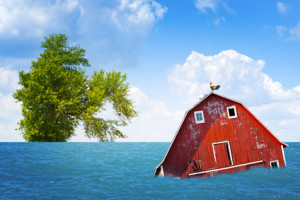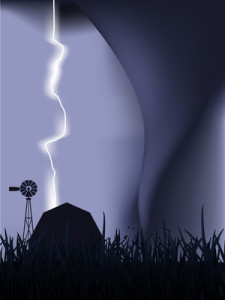Natural Disasters Catastrophic Events For Our Horses
Written by Anna Helman
Natural disasters and devastation go hand-in-hand. Natural disasters in our horse community can often result in the loss of our beloved horses, our dream barns and houses, and our life savings. In today’s blog, I will describe the average emergency plan for each type of natural disaster. Yet for such traumatic events, former CNN anchor Daryn Kagan said it best when he stated that, “bad things do happen in this world, like war, natural disasters, and disease. But out of those situations always arise stories of ordinary people doing extraordinary things.”
Please remember that national disasters are highly divergent so these preparation plans are not always the best choice for your particular situation. As a horse owner, it is always crucial to trust your horse-knowledge and instincts.
Floods
Action: Evacuate
Preparations:
* Have a designated barn at a higher elevation
* Know the routes to get to your designated location
o Make sure these routes are not in the flood zone or are predisposed to being shut down
* Each driver should be assigned a trailer that they have had experience driving
* Each trailer should be assigned individual horses
* Know the amount of time it would take to evacuate the entire barn to the designated location
* Make sure trucks and trailers are well-maintained
* Pack enough grain and hay in the trailer to feed your horses for multiple days
Evacuation Plan:
If you are ever unsure whether or not to evacuate your barn, it is always better to error on the side of caution. Evacuations are tedious but floodwaters have the capability of rising extremely fast. During potential flooding times make sure you have trailer drivers on stand-by, you are continually watching the weather projections and monitoring how your property is beginning to flood.
Tornados
Preparations:
* Each horse should have a leather halter
* Duck tape, vet wrap, and spray paint should be stock-piled in your barn
Evacuation Plan:
Horses have a much greater chance of surviving when running free rather than being locked in a stall. Releasing your horse(s) does not mean releasing them into a paddock but rather into the community. When you release your horse(s), have your phone number on their halters and on their bodies. For their halters, you should wrap vet wrap around the check piece of the leather halter. Then wrap the duck tape around the vet tape and write your phone number on the duck tape. Using the spray paint, you should spray your phone number on the body of your horse, on both sides. After the tornado, the halter will allow your horse to be caught but if your horse cannot be caught, someone can call you by reading the phone number on their side. Micro chipping your horse is also beneficial in the situation.
Hurricanes
Actions: Release
Preparations:
* Preparation for this plan is a replication of the tornado plan
Evacuation Plan:
The paths of hurricanes are highly unpredictable so having a designated barn would not provide much security. As with a tornado, horses have a higher likelihood of surviving when running free. Spray paint your phone number on both sides of your horse and write your number on the piece of duck tape on the check piece of your horse’s leather halter.
Blizzards/Heavy Snow
Actions: None
Preparations:
* Make sure someone can easily access the barn during snowy conditions (lives nearby, has 4-wheel drive vehicle)
* Have large stock-piles of hay and bedding
* Make sure all water-heaters are in good condition and operating well
Plan:
During blizzards/heavy snow, your horses should be cozily tucked away in their stalls. In extremely cold weather, it is important to give your horse plenty of hay and water. By eating hay, horses can maintain their internal body temperature and also remain occupied. Then a constant supply of clean, fresh water will prevent them from becoming dehydrated and possibly colicing.
Brush/Forest Fires
Actions: Evacuate
Preparations:
* Preparation for this plan is a replication of the flood plan
Evacuation Plan:
Your designated barn should be far away to ensure that it would be a safe distance away from the fire (usually hours away). A distant designated barn means that your traveling times will greatly increase so plan to have plenty of trailers and drivers in order to evacuate your entire barn. In the case that your barn burns down, you should have a back-up plan for taking care of your horses until you can relocate them.
-
Articles
- April 2024
- March 2024
- February 2024
- January 2024
- December 2023
- November 2023
- October 2023
- September 2023
- August 2023
- July 2023
- June 2023
- May 2023
- April 2023
- March 2023
- February 2023
- December 2022
- November 2022
- October 2022
- September 2022
- August 2022
- July 2022
- June 2022
- May 2022
- April 2022
- March 2022
- February 2022
- January 2022
- December 2021
- November 2021
- October 2021
- September 2021
- August 2021
- July 2021
- May 2021
- April 2021
- March 2021
- February 2021
- January 2021
- December 2020
- November 2020
- October 2020
- September 2020
- August 2020
- July 2020
- June 2020
- May 2020
- April 2020
- March 2020
- February 2020
- January 2020
- December 2019
- November 2019
- October 2019
- September 2019
- August 2019
- July 2019
- June 2019
- May 2019
- April 2019
- March 2019
- February 2019
- January 2019
- December 2018
- November 2018
- October 2018
- September 2018
- August 2018
- July 2018
- June 2018
- May 2018
- April 2018
- March 2018
- February 2018
- January 2018
- November 2017
- October 2017
- September 2017
- August 2017
- July 2017
- June 2017
- May 2017
- April 2017
- March 2017
- February 2017
- January 2017
- December 2016
- October 2016
- September 2016
- August 2016
- July 2016
- June 2016
- May 2016
- April 2016
- March 2016
- February 2016
- January 2016
- December 2015
- November 2015
- October 2015
- August 2015
- June 2015
- May 2015
- March 2015
- November 2014
- March 2014
- October 2013
- September 2013
- August 2013
- January 2013
- December 2012
- November 2012
- October 2012
- September 2012
- January 2012
- October 2011
- September 2011
- August 2011
- July 2011
- June 2011
- February 2011
-
Meta







